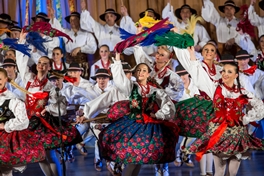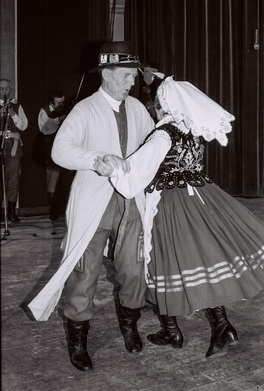Traditional dance is the first of several facets of the educational website launched by the Institute of Music and Dance with the view to presenting a wide range of dance genres and forms. The website is a free online educational and popular science platform addressed to a broad spectrum of those interested in the historical and contemporary presence of traditional dance in Polish culture.
Feel free to use the materials uploaded to the portal. The website is intended for all dance enthusiasts: adults and young people, amateurs and professionals, animators of culture, pedagogues and academic teachers, for whom it may serve as both a source of knowledge and inspiration. The portal may also be of some help to dancers, choreographers and researchers who deal with dance on a daily basis.
The basic form of dance presentation on the website is through archival and new videos featuring performances of individual dances. They have been rendered available by the archives of governmental and local institutions as well as non-governmental organizations and private persons. Apart from films, the website also includes descriptions of dances along with photographs, prints, audio files and instructional videos to assist in teaching particular dance forms. The portal also contains a rich bibliography of academic and popular science publications.
There are many ways in which you may find the information on specific dances, from looking it up in the alphabetical list of dances, through searching by ethnographic region and basic choreotechnical form.
The idea of the website was symbolically initiated in 2014, celebrated as the Year of Oskar Kolberg, in the form of a “site in progress”, systematically supplemented with new archival and dedicated materials through the years. The portal will be home to both non-stylised dance forms and prepared and stylised stage arrangements, as well as historical (early) and national dances.
Professional literature includes several proposed typologies of dances in Polish culture. The authors of the website adopted a simplified choreological classification of dances and dance games based on literature and their own experience. The classification is founded on the following categories: solo dances and dance games, pair dances, dances performed by three dancers, and processional dances. Historical (early) dances, along with Polish national dances and dances and games for children, will be presented in separate groups. We hope that the proposed typology will prove legible and useful to everyone visiting the website.
Many dance forms encountered in ethnographic and historical literature have not been preserved in their actual forms, which were inseparably connected with ancient rituals and regional customs. Some dances commonly considered as Polish in fact come from other cultures and were merely adapter to local traditions and fashions. Some dances are known only as names and descriptions (sometimes specific enough to be regionally reconstructed and presented on stage). Then there are dances which emerged in the past century or were processed from strictly traditional to more contemporary forms for the sake of their stage presentation or dancing parties. The classification of film materials to particular categories (e.g. prepared / non-prepared dance, pair / processional dance) has sometimes been done subjectively, demonstrating the indefinite character of such divisions.
Authors: Romana Maciuk-Agnel, Robert Dul (PhD), Jacek Jackowski, Jan Łosakiewicz, Tomasz Nowak (PhD), Piotr Zgorzelski
Editors: Konrad Niciński, Joanna Targoń
English translation: Robert Dul (PhD), Józef Jaskulski, Monika Tacikowska
Web site design: Studio Robot
Financed by the Ministry of Culture and National Heritage of Poland as a key project to mark the Kolberg Year.






